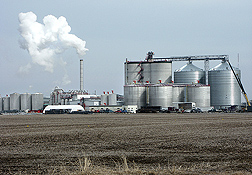This page has been archived and is being provided for reference purposes only. The page is no longer being updated, and therefore, links on the page may be invalid.
Read the magazine story to find out more. |
|
|
Ethanol "Leftover" Has Weed-Fighting Potential
By Jan SuszkiwMay 14, 2007
Distiller's dried grains (DDGs)—coproducts of converting corn into ethanol—are usually fed to livestock. But a new use could be on tap: fighting weeds and reducing herbicide use.
That's the hope of plant physiologist Steve Vaughn and colleagues with the Agricultural Research Service (ARS) in Peoria, Ill. There, at the National Center for Agricultural Utilization Research (NCAUR), Vaughn is among approximately 100 scientists seeking to identify new, value-added uses for farm-based commodities like DDGs and help bring them to commercial fruition by developing novel processing technologies.
In laboratory, greenhouse and field studies over the past few years, Vaughn has shown that applying DDGs to soil as a surface mulch can not only suppress weeds, but also bolster the growth of tomatoes and some turfgrasses. In one study, for example, Roma tomatoes in DDG-treated plots yielded 226 pounds, versus 149 pounds from untreated control plots.
Vaughn attributes some of the increase to nitrogen, phosphorus and other nutrients released by the DDG mulch as it decayed.
In another study, using various analytical methods, NCAUR collaborator Mark Berhow is seeking to identify, measure and monitor the activity of the chemicals in the DDG mulch that may have kept chickweed, annual rye and other weeds from germinating.
Rick Boydston, an ARS collaborator at Prosser, Wash., tested the mulch's weed control in potted ornamentals, including roses. He observed that DDGs worked best when applied to the soil surface, because mixing them into the soil harmed both ornamentals and weeds alike.
On another front at Peoria, ARS chemist Rogers Harry O'Kuru is examining DDGs for phytosterols, lecithin and other substances with potential use as health-promoting food ingredients.
The team's efforts to expand the market for DDGs are timely. In the Midwest, ethanol producers generate 10 million tons of DDGs annually. Farmers buy most of it for about $80 per ton and feed it to cows and other ruminants. However, the nation's increasing production of ethanol may create a DDG surplus that exceeds the current demand, Vaughn notes.
ARS is the U.S. Department of Agriculture's chief scientific research agency.
Read more about the DDG research in the May/June 2007 issue of the agency's Agricultural Research magazine.

